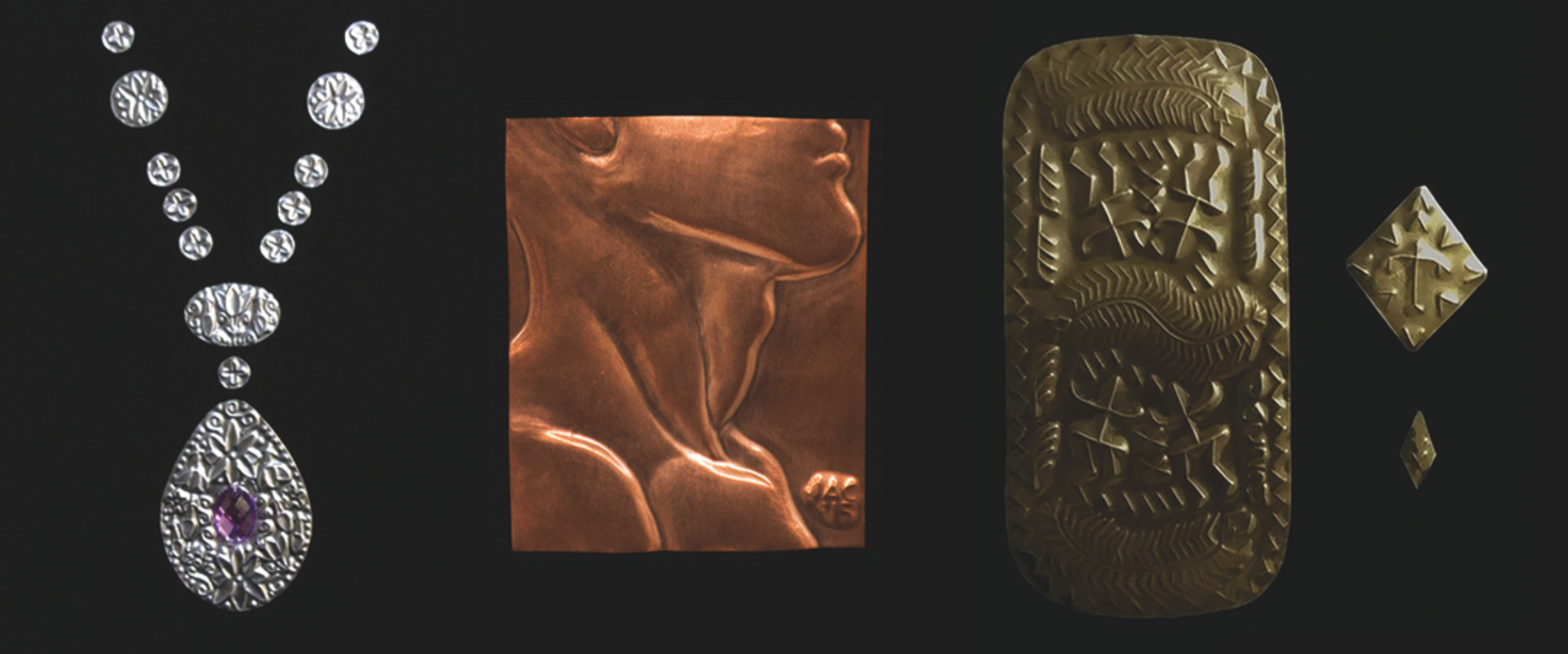by Joseph Andrew “Jandy” A. Carvajal
In hindsight, it is always fascinating to realize how one thing led to another, even with decades in between. This is most true with my current art practice largely involving embossing metal sheets. On the seventh-year anniversary of PLATA FLORA, my solo exhibit of aluminum reliefs at the Cultural Center of the Philippines, I look back on my repoussé explorations, their beginnings, and inspirations.
Repoussé is an ancient technique of embossing metal sheets by pressing or hammering their reverse side. The result is often a relief sculpture, where one side is raised, the other flat. In the Philippines, pre-Hispanic gold artifacts, from jewelry to death masks, exemplify this technique, among others. Nowadays, this method of creating metal reliefs is evidenced by the haloes and crowns of Catholic saint statues, processional floats (carozas), and horse-drawn carriages (calesas).
In 1991, I first explored repoussé using protective aluminum from milk cans. As Chicano studies scholar Tomás Ybarra-Frautso would describe rasquache sensibility, I made do with what I had. I was already incorporating recycling into my early art practice, albeit a latent advocacy. I created a decorative series from these salvaged materials, informed by my early inspirations: Catholic sacramentals, observed at home, in church, and during Holy Week. What drew me in were their unique combination of color, luster, and texture, along with associations of luxury and divinity. Though I enjoyed creating metal reliefs then, I had to shelf my repoussé exploration due to school and other responsibilities.
Almost two decades later, I did a photomanipulation of two of these early works. I digitally transformed aluminum into gold. My newfound inspiration for this were the pre-Hispanic Philippine gold artifacts that I was privileged to see during a series of museum visits in 2009. They were a feast for the eyes indeed. I most remember Ayala Museum’s Gold of Ancestors exhibit, which included artifacts from the Visayas, whose peoples were described in 16th century accounts as adorned in gold. I was filled with pride in our forebears: ancient artists gifted with skills in manipulating the precious metal.
Due to these new inspirations, I revisited my repoussé exploration using salvaged aluminum. Among my new outputs referenced votive medallions (ex votos) and reliquary pendants (tamborin). Still drawing from my Catholic background, I soon created and exhibited PLATA FLORA (2014), a 32-piece collection depicting various blossoms, from wildflowers to cultivated orchids, arranged in a procession alluding to the tradition of offering flowers to Mother Mary. This public presentation became a fitting venue to also highlight how recycling can be part of contemporary artmaking.
While pursuing my MFA degree in the US (2014-2016), I started embossing other metals such as copper and brass, featuring figures, and other content. Access to well-stocked art supply stores prompted me to try other metals. I did not abandon aluminum and recycling, however. Aluminum beer cans and take out containers were readily available materials for some of my outputs. During critique sessions, open studios, and exhibits, it was encouraging to hear appreciative feedback about my metal reliefs, which became my way to distinguish myself as a Filipino artist in a foreign land.
Back home, my explorations continued. I referenced local folk art traditions, including tattoos, textiles, papercutting, and wood carving. In 2018, recognizing how some tourists aspire to be inked with traditional Cordilllera tattoo motifs, I recontextualized these images on brass: read separate from skin, making them open to new interpretations, just as “outsiders” carry and make sense of these marks from another culture. It was also in 2018 that I first thought of having my brass repoussé gold-plated, to emphasize value placed on the subjects, such as ideal body parts.
I used this combination of brass repoussé and gold for my recent solo exhibit in 2021, “Mga Kayamanan sa Bakuran” (Treasures in the Yard) which depicts vegetables grown by Filipinos during the first months of the lockdown due to the current pandemic. This body of work was my response to the theme “The Filipino Scholar in Virulent Times” of the 8th International Research Forum on the Philippines, where I expounded on the rationale behind my exhibit. The inedible gold ironically underscores that food is more valuable. The juxtaposition reiterates that hunger is equally a threat.
30 years since I created my first repoussé pieces, I continue to appreciate the two main sources of inspiration for my explorations: Catholic sacramentals and pre-Hispanic gold artifacts. I am grateful to our kababayans from centuries past for their artistic legacy which served as a pivotal catalyst for my continued art practice, open to responding to present-day realities.
(An essay is an extended version of the presentation delivered at the 2021 Annual Philippine Studies Conference at SOAS University of London, June 26, 2021.)

One of Jandy’s early repoussé on salvaged aluminum from 1991.

Sayote, gold-plated brass repoussé (2021), presented at the 8th International Research Forum on the Philippines

Jandy’s explorations in aluminum (2012), copper (2015) and brass (2019).

An installation view of PLATA FLORA at the Cultural Center of the Philippines, 2014.

Kampanilya, repoussé on salvaged aluminum (2013), part of the PLATA FLORA exhibit
(All photos by © Jandy A. Carvajal)
About the author:
Joseph Andrew “Jandy” A. Carvajal is Assistant Professor of Fine Arts at UP Baguio.
(This essay is an extended version of the presentation delivered at the 2021 Annual Philippine Studies Conference at SOAS University of London, June 26, 2021.)
